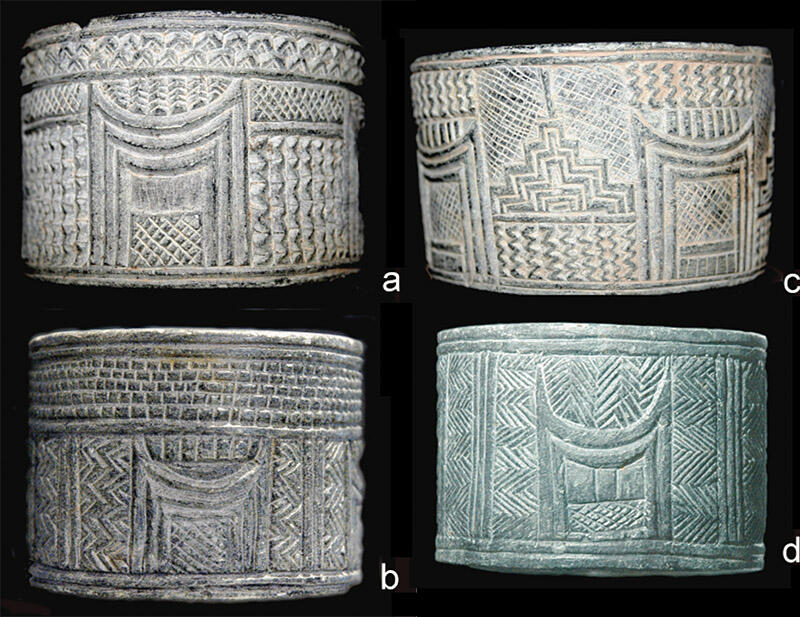"Correlating ancient textual sources with iconography and archaeological evidence in general is notoriously a controversial exercise, constantly carried out on endemically slippery grounds," writes the author at the very start. Then he launches into a formidable analysis that teases out a wide variety of correspondences across ancient cultures to develop a thesis around the triple "hut" design on chlorite vessels from the Bronze Age Jiroft or Halil Rud (Marhashi) civilization. "Commonly referred to as the ‘hut’ motif, this pattern was traditionally considered an important component of an ‘intercultural style’ adopted by a network of different craft communities fabricating highly decorated stone artifacts from the Gulf to south-eastern Iran" (p. 7)." It even made its way to Mohenjo-daro and seems to have been involved in designs used for buildings in Mundigak in Afghanistan, which also flourished during the height of the ancient Indus civilization. As it were, this turns out to be a very deep motif, linking to early myths about a prehistoric flood (there are so many cultures which have a story like this, it must be true!) in Zoroastrian Iran, and stories of how man and the animals were saved underground in a rendition of a "hut" structure laced with complex symbolism and design fragments. It is a compelling analysis, not proven directly because we don't have access (yet) to the ancient words that would have supported such a reading of the motif on many objects from Jiroft, but compelling for so many reasons, among them the author's erudition and knowledge of a vast region he was been working in for decades and is one of its leading archaeologists.
There are also many important structural points on linking political economies, symbolism, and the development of cultures at the time worth pondering. Particularly interesting is Vidale's bringing on the palm tree and dates, with the valuable nourishment they contain and how the complexity of their agricultural exploitation might favor larger social structures that were linked to their form of expression in stone vehicles and buildings. "Palm management requires intensive human cooperation: in the first place, in the form of surface artificial irrigation, traditionally managed in these arid lands through simple earthworks and small canals, but by the means of intensive and constant labor. Management of water also requires the development of formal legal arrangements to ensure ‘equal’ distribution rights across the farming families, and thus recognition of the practical effects of certain shares of inequality. Palms often have to be artificially pollinated and offshoots are often inter-exchanged and transplanted from oasis to oasis with specific agreements, promoting inter-village cooperation. Palms orchards are long-term investments, because fruits will be edible for only 5-8 years, coming to maturity after 40 years, but remain fruitful up to a century" (p. 19). Truly early civilizations must have developed in close harmony with animals and crops, each of which would have seemed magical in the benefits they brought if properly cared for.
Also very interesting is how the motif seems to be strongest in Jiroft valley, and while it became intercultural and spread across a wide area, it also seems to have been "indigenous" to that culture. Even as we see in the third, fourth, fifth millenniums more "internationalism" ever more cross-currents among peoples than we may ever have expected with travel on land so cumbersome, we also see very deep unique features and traditions develop in specific towns and regions before then spreading. One has to keep two contradictory assumptions in mind at the same time "and still retain the ability to function" as F. Scott Fitzgerald put it. In so many ways, ancient times were extraordinary rich, collaborative and full of "start-ups."
Vidale draws a really meaningful and thought-provoking analogy: "Think – if I am allowed an unorthodox comparison – of the castle selected as a symbol of the Disney company: invented in the United States as a re-interpretation of Central-European castles, built in various periods with their pinnacles from the 12th century onward; in historical terms, they are forgeries and fiction; but, on the waves of the planetary triumph of the company, it became real in various Disney amusement parks, to be visited by millions of young and old. Is it real or fictional? Where do fictions or mythologies stop, and historical contingencies begin? And are the crowds actually aware, when enjoying the visit, of the complicated history of these constructions? Or the crucial cultural aspect is just that this powerful architectural symbol, on the contrary, is enjoyed at another level, and spread just because its mutable meanings effortlessly evolved from a cultural horizon to the following ones?" (p. 11).
Vidale ends his tour-de-force with these words: "The recent discovery, in the Halil Rud production, of a quite visual narrative of a flood generated by powerful winged bulls as the clouds, and terminating with the erection of a rainbow in the sky (Figure 10, see Vidale 2015), dated around 2400-2300 BC, ascribes this imaginary scenario to the first fully urban communities of the eastern Iranian Plateau, but also to a ideological background pre-existing the Indo-Iranian heritage. Eventually, if the ‘hut’ motif in the same craft tradition, as I propose, represents a vara, this reconstruction is strengthened; together with the emphasis on palms and dates, this suggests that south-eastern Iran of the second half of the 3rd millennium BC should be fully included in the sphere of cultural interaction we conventionally define with the term of Proto-Indo-Iranian" (p. 25).
Image: Examples of cylindrical pots in chlorite decorated with the ‘hut’ motif at the Jiroft Museum. Photo M. Vidale.

